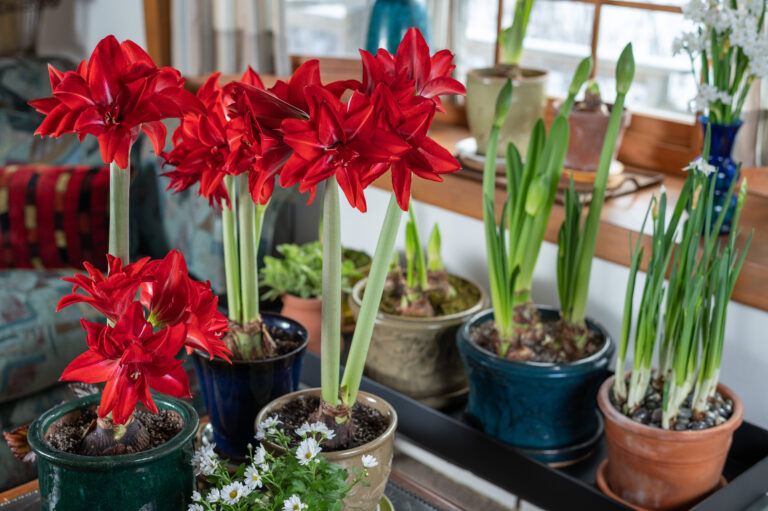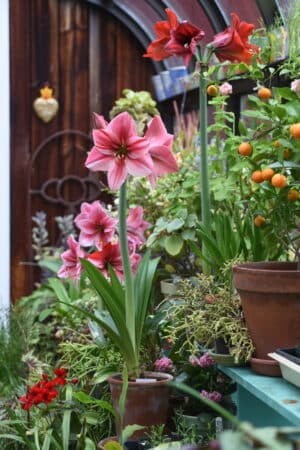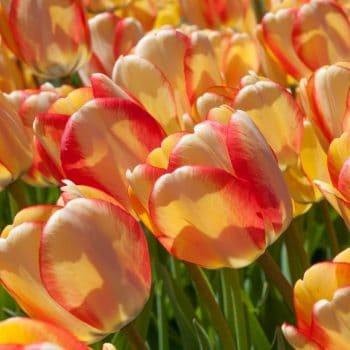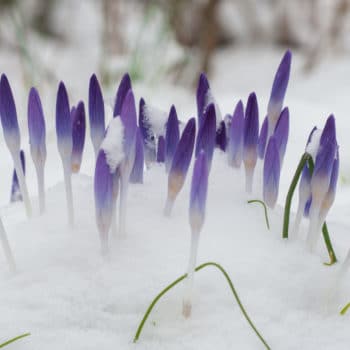by Tovah Martin

While your garden is slumbering outside in the middle of winter, amaryllises are performing major stunts in your home. Like magic, they are sending up their big, flashy flowers to get you through a time when nothing else is happening. Big, buxom, and bodacious, it doesn’t get any better than growing amaryllis bulbs for plant ‘wow’.
When you’ve got something as snazzy as an amaryllis, you naturally want more than one. After all, the more the merrier. Getting several of the same variety is a savvy artistic move. Visually, growing amaryllis flowers in multiples makes a strong design statement.
Use Amaryllis in Design
Think about it: You design in multiples outdoors, so there’s no reason why your houseplants shouldn’t serve the same function with similar design tenets. In the garden, you often repeat shapes, colors, and individual plants to create continuity. That’s what design is all about. Take those same concepts and bring them inside.
 The beauty of growing amaryllis bulbs is that they share a very unique profile. Large flowers are carried on a tall, straight stem. That silhouette makes them perfect companions for coupling with a grouping of other plants. Amaryllises hold their blooms well above a sea of neighbors.
The beauty of growing amaryllis bulbs is that they share a very unique profile. Large flowers are carried on a tall, straight stem. That silhouette makes them perfect companions for coupling with a grouping of other plants. Amaryllises hold their blooms well above a sea of neighbors.
Consider all the possibilities for combos. Amaryllises grow in a bright south-facing window or an east- or west-facing windowsill, and so do many other houseplants. Colorful companions such as geraniums, begonias, succulents, peperomias, and innumerable other readily available windowsill favorites are perfect for the role. Or go with a foliage plant such as an ivy, pothos, or philodendron.
Trailing plants work wonderfully with amaryllises, or spiky plants give the display more height. Combine them together so that the amaryllises echo hues in the foliage of their windowsill-neighbors. For example, red amaryllises such as Rapido, Magnum, Silver Dream, and Double Delicious have a dialogue with crotons and other houseplants with colorful leaves.
Pick up on varying shapes. Star-shaped Doublet would work magic combined with cordylines, aloes, and agaves. Combine the double flowering amaryllises in the Amplitude mix with wide open-faced amaryllises like Moscow or Rosy Star. This is your opportunity to be an artist/designer, so let the creativity flow.
Growing Amaryllis to Make a Statement
You can also weave your amaryllis thread through your décor. If you tend to leave your holiday decorations intact through winter, the good news is that the hues in amaryllises will echo the traditional glowing colors to hold the holiday mood. Even if you go with gold or silver, amaryllises will complement the bling. Or just let your multiple amaryllises sparkle on their own. They are fully capable of keeping your spirits bright without any help whatsoever.
So, how is it done? As with all good things, you could do this several ways. You could pot your amaryllis bulbs in separate containers, perhaps picking a theme—like several repeating swank terra cotta containers or a series of kitschy metal cachepots. Be sure your container provides drainage because amaryllis roots don’t love sitting in soggy soil. Potting amaryllis in one container is traditional, but you could try potting three amaryllis together in one container for a superdeluxe extravaganza. Amaryllis prefer the same typical living temperatures that we find comfortable in our homes. Give the bulbs good light and then just sit back and enjoy the show.


